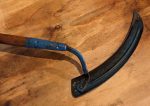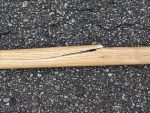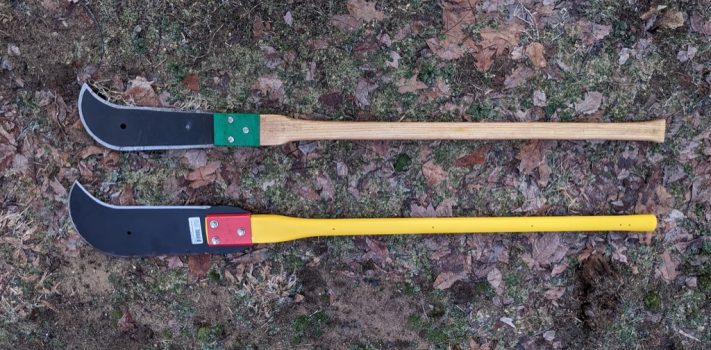Prologue: The Dacian Wars: 101-102 and 105-106 AD
During all of their far-flung campaigns, the Roman Legions had never faced a weapon as fearsome as the Dacian falx (“sickle”). The large falx was a two-handed weapon with a roughly 3-foot blade mounted on a roughly 3 foot handle. The long handle provided a tremendous amount of leverage, giving the weapon enough power to split a legionnaire’s helmet or shield with a single blow.
After seeing a large number of Roman corpses with gruesome head wounds, the armorers accompanying the legions adopted a field expedient: they riveted two transverse reinforcing iron straps to the crown of the imperial helmet. The straps worked, and became a permanent feature of the imperial helmet. During the more than 500 years that the Roman Empire existed, this alteration was the most significant modification to the equipment of the Roman Legionnaire.
The Bottom Line, Up Front
I recently acquired a tool that has much in common with the Dacian falx. It is a Valley GTDB-48 Ditch Bank Blade. A yellow 42-inch fiberglass handle topped by a double-edged 16-inch blade provides tremendous cutting power for clearing brush along my driveway.
At the time of this writing, the GTDB-48 was available from Zactools.com for $75.41. It is assembled in the USA by Valley Industries of Paramount, California using American-made fiberglass handles and Chinese-made steel blades.
If you need to clear brush, I recommend the GTDB-48 as a highly effective hand tool for that task.
Background
For most of its length, my driveway runs about two feet above a surrounding wetland. The vegetation surrounding the driveway wages a relentless campaign to overrun my driveway and reclaim it for the wilderness. In the past I have used a machete, a weed wacker, a chainsaw and a lawnmower to try to hold the encroaching hoards at bay. Recently I have added several weapons to my arsenal to help me resist this inexorable enemy.
A Grass Hook
 The first weapon that I added was a Col-Cut 36 inch steel grass hook. The grass hook was manufactured by the now-defunct Columbian Cutlery Company of Reading, Pennsylvania. It appears identical with the Razor-Back 36 inch steel grass hook that is currently made in the USA and was available for $29.99 from www.acehardware.com at the time of this writing. It is also similar to the Truper 36 inch long handle grass hook that is made in Mexico and was available for $35.99 at www.doitbest.com at the time of this writing.
The first weapon that I added was a Col-Cut 36 inch steel grass hook. The grass hook was manufactured by the now-defunct Columbian Cutlery Company of Reading, Pennsylvania. It appears identical with the Razor-Back 36 inch steel grass hook that is currently made in the USA and was available for $29.99 from www.acehardware.com at the time of this writing. It is also similar to the Truper 36 inch long handle grass hook that is made in Mexico and was available for $35.99 at www.doitbest.com at the time of this writing.
My Col-Cut grass hook has a 36-inch wooden handle with a 4-inch metal bracket at the end which attaches in turn to a 12-inch steel blade. I bought the grass hook for $6 at a thrift store.
The handle gives two major advantages over the machete. The first is that it reduces the need to bend over while I am cutting, thus bringing great relief to my lower back. The second major advantage is leverage. I am able to cut back the encroaching tangled mass of saplings, thorny wild rose, wild grape vines and other vegetation with much greater speed and power than I can achieve with a machete.
Limitations
The major drawback of the grass hook is that the 4-inch metal bracket at the end of the pole is not really robust enough to stand up to the torque produced by the blade slashing through heavy underbrush. The bolts that hold the blade to the bracket have a tendency to work themselves loose or shear off, and the bracket has a tendency to gradually bend backward upon itself. I need to periodically straighten the bracket with a hammer on the anvil on my vise and replace the bolts and secure them with Loctite.
A Pole Saw
The second major weapon that I added was a battery-powered pole saw. Saplings that are too thick to be cut with a machete or grass hook are easy to cut with the pole saw. The pole enables me to make these cuts without bending down and crawling into the brush like I used to have to do with the chainsaw.
A Generic Ditch Bank Blade
 When I ran across a generic ditch bank blade on Facebook Marketplace for $20, I recognized it as a more robust alternative to the grass hook. The junction between the handle and blade is much stronger than the bracket on the grass hook. The straight alignment of the junction between the blade and handle of the ditch bank blade produces much less torque than the curved alignment of the junction between the blade and handle of the grass hook.
When I ran across a generic ditch bank blade on Facebook Marketplace for $20, I recognized it as a more robust alternative to the grass hook. The junction between the handle and blade is much stronger than the bracket on the grass hook. The straight alignment of the junction between the blade and handle of the ditch bank blade produces much less torque than the curved alignment of the junction between the blade and handle of the grass hook.
 That first ditch bank blade was not marked with the name of any maker or place of manufacture on either the handle or the blade. I suspect that information was originally on a sticker that has subsequently been removed. It appears similar to the Council Tool 640C 40 inch Steel Double Edge Ditch Bank Blade which is made in the USA and was available from www.acehardware.com for $64.99 at the time of this writing. It also appears similar to the Truper 16 inch Steel Ditch Bank Blade which is made in Mexico as was available from www.doitbest.com for $52.99 at the time of this writing. The only problem with the generic ditch bank blade was that I managed to crack the hickory handle after only about 30 minutes of use. I guess that I was just swinging it too hard. I am sorry to admit that this is not an unusual experience for me. I can be a bit hard on my tools.
That first ditch bank blade was not marked with the name of any maker or place of manufacture on either the handle or the blade. I suspect that information was originally on a sticker that has subsequently been removed. It appears similar to the Council Tool 640C 40 inch Steel Double Edge Ditch Bank Blade which is made in the USA and was available from www.acehardware.com for $64.99 at the time of this writing. It also appears similar to the Truper 16 inch Steel Ditch Bank Blade which is made in Mexico as was available from www.doitbest.com for $52.99 at the time of this writing. The only problem with the generic ditch bank blade was that I managed to crack the hickory handle after only about 30 minutes of use. I guess that I was just swinging it too hard. I am sorry to admit that this is not an unusual experience for me. I can be a bit hard on my tools.
I took the generic ditch bank blade to the pole barn, where I introduced as much waterproof wood glue into the crack as I could. I then clamped the cracked sections together, wiped off the excess glue, and left the glue to dry.
I was not satisfied with the result. The crack did not look like it mended well. I began looking for a fiberglass replacement handle. When I could not find one, I began looking for a ditch bank blade that came with a fiberglass handle.
The Valley GTDB-48 Ditch Bank Blade
I eventually found the Valley GTDB-48 Ditch Bank Blade online. I placed my order, and a couple of weeks later, a 12 pound package was delivered via UPS Ground.
The blade arrived moderately sharp, so I decided that I could begin testing it without any further sharpening.
 The heavy 12 gauge blade is made of high carbon hot rolled steel. It is much larger and much heavier than the blade on the generic ditch bank blade. The hefty yellow fiberglass handle is also much heavier than the hickory handle of the generic ditch bank blade. (Both are shown, on the right. Note the yellow-handled GTDB-48, below, versus the hickory-handled “generic”, above.) As a result, the GTDB weighs about 7 pounds on the fish scale in my tackle box in contrast to the 3.5 pounds of the generic ditch bank blade. The extra heft makes the GTDB-48 more fatiguing to swing, but a much more powerful cutter.
The heavy 12 gauge blade is made of high carbon hot rolled steel. It is much larger and much heavier than the blade on the generic ditch bank blade. The hefty yellow fiberglass handle is also much heavier than the hickory handle of the generic ditch bank blade. (Both are shown, on the right. Note the yellow-handled GTDB-48, below, versus the hickory-handled “generic”, above.) As a result, the GTDB weighs about 7 pounds on the fish scale in my tackle box in contrast to the 3.5 pounds of the generic ditch bank blade. The extra heft makes the GTDB-48 more fatiguing to swing, but a much more powerful cutter.
The tool is a real beast. It goes through stems and saplings less than 0.75 inches thick like a hot knife through butter. Thicker saplings may require several swings to drop. I would not recommend it for brush thicker than about 2 inches. For that thicker diameter brush, I would recommend a battery-powered pole saw if you have the ability to recharge it.
Both edges of the GTDB-48 blade are sharpened. I found it worked best for me to use the convex edge of the blade for cutting, and the concave edge for snagging what I had already cut in order to fling it into the swamp. Using the blade to fling the cuttings was convenient, since many of those cuttings were thorny wild rose stems that can often penetrate gloves.
Over several sessions, I found that I could clear about a yard of bank a minute using the blade. About 30 minutes of use was about all I wanted to handle in a single session. Since my driveway is about 300 yards long and has banks on both sides, it will take me about 10 hours of cutting or about 20 sessions of 30 minutes each to finish clearing the edges. By then, it will be time to go back to the other end, and get started again. The good news is that if I stay on top of it, the process will get gradually easier as the undergrowth I am cutting has less time to firmly establish itself.
Cleaning
After each session, I cleaned the blade with a nylon brush followed by a steel brush. I then sharpened the edges with a whetstone and applied a thin film of used motor oil to the blade with a rag.
There is a hole in the middle of the blade to allow it to be hung on the wall. The hole was initially too small to fit over a construction screw head. I enlarged the hole slightly with a grinding bit on a rotary tool, with excellent results.
Conclusions
The Valley GTDB-48 Ditch Bank Blade is an excellent hand tool for clearing brush. It is heavy enough that I would not want to swing one all day long. But if you can pace yourself in a series of shorter sessions over the course of days, weeks, or months, the process becomes much more manageable.
Disclaimer
I did not receive any financial or other inducement to mention any vendor, product, or service in this article.










